Todd-AO Equipment Catalog, Volume II |
Read more at in70mm.com The 70mm Newsletter |
| Captions by: Brian O'Brien, Jr. around 1955. Images by: American Optical Company, around 1955. | Date: 21.05.2014 |
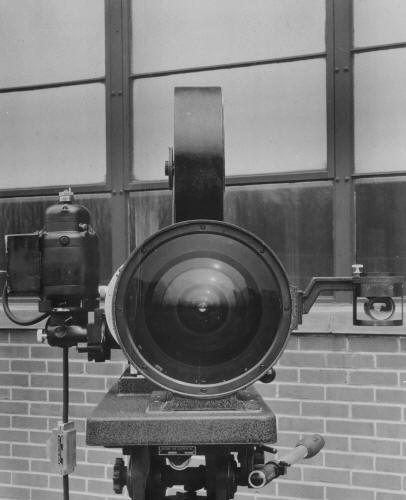 Front view original “Bugeye” 135-degree lens on number one
Todd-AO prototype camera.
Wild motor and follow finder mounted. Front view original “Bugeye” 135-degree lens on number one
Todd-AO prototype camera.
Wild motor and follow finder mounted.About the 65mm ex-Thomascolor - now prototype Todd-AO camera - by Brian O'Brien, Jr. 29. September 2004: The Pullman Company had been forced by the government to sell their railroad car business. This left them with a large amount of cash, and they were looking for businesses to invest in. They engaged my dad to consult for them on a new color motion picture process called Thomas Color. It involved a camera with an image splitter to record three black & white color separation images on each frame of 65mm B&W film. These would then be recombined through red, green, and blue additive color filters and superimposed on the screen by the projector giving a full color picture. The present day monopack color films were in early development, so the future of Thomas Color did not seem bright. Pullman decided against investing, and the process never went anywhere. I heard a rumor about some wide film cameras being stored in a warehouse in Hollywood and immediately flew out there to investigate. Sure enough it was the old Thomas Color equipment. There was one complete camera, and parts for five more, a complete set of blueprints for them, a 65mm film perforator, edge numbering machine and a small film splicer. I immediately issued a purchase order for the whole collection and had it shipped to Southbridge, and that is how we started with 65mm film. |
More in 70mm reading: Back to Todd-AO Catalog • Todd-AO Birth date • How Todd-AO Began • Todd-AO Home • DP70 / Universal 70-35 / Norelco AAII - The Todd-AO Projector Internet link: |
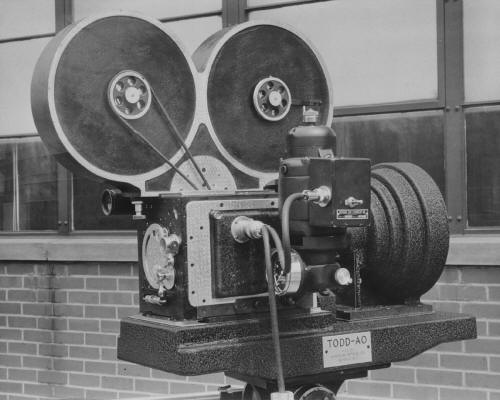 Number One camera on base with original “Bugeye” 135-degree lens and
wild motor. This camera was the only one assembled of the batch we
bought from Thomas Color. Number One camera on base with original “Bugeye” 135-degree lens and
wild motor. This camera was the only one assembled of the batch we
bought from Thomas Color. |
|
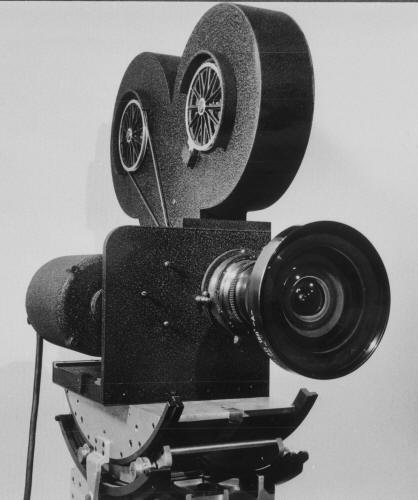 Production camera and production “Bugeye” lens, with Sync. Motor on
camera. All mounted on Worral geared tripod head. Production camera and production “Bugeye” lens, with Sync. Motor on
camera. All mounted on Worral geared tripod head. |
|
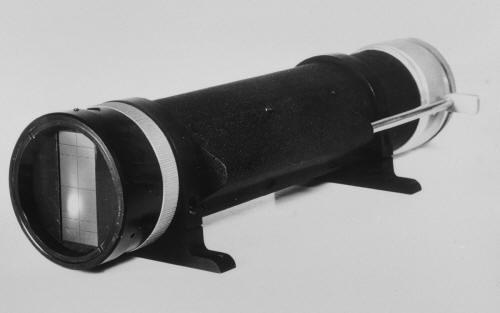 Rack-over finder with Todd-AO frame mask. Rack-over finder with Todd-AO frame mask. |
|
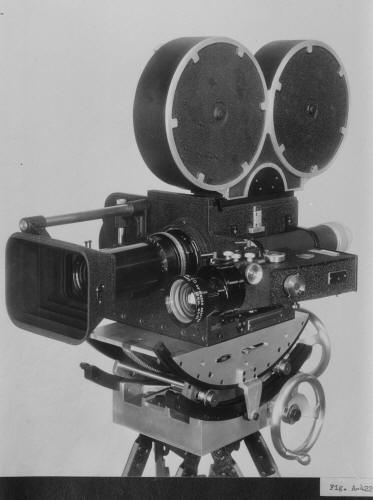 Fig. A-422.
Todd-AO Camera arranged to take the bayonet lenses. This view shows the 64°
Camera Objective, Wide-angle Follow Finder with its 64° Adaptor and
Wide-angle Matte Box mounted in operating position. The camera is mounted on
the Geared Tripod Head. Fig. A-422.
Todd-AO Camera arranged to take the bayonet lenses. This view shows the 64°
Camera Objective, Wide-angle Follow Finder with its 64° Adaptor and
Wide-angle Matte Box mounted in operating position. The camera is mounted on
the Geared Tripod Head.Todd-AO Camera (Cat. #01) 64° Camera Objective (Cat. #06) Wide-angle Follow Finder (Cat. #14) 64° Adaptor (Cat. #16) Wide-angle Matte Box (Cat. #21) Geared Tripod Head (Cat. #24) |
|
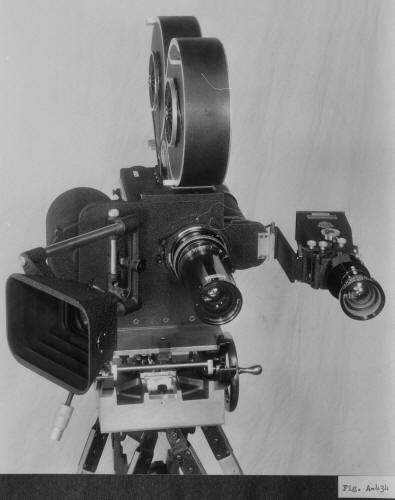 Fig. A-434.
Todd-AO Bayonet Camera mounted on Geared Tripod Head, showing 64° Bayonet
Lens in place with special Wide-angle Matte Box swung aside and the
Wide-angle Follow Finder on forward 64° mounting bracket. Fig. A-434.
Todd-AO Bayonet Camera mounted on Geared Tripod Head, showing 64° Bayonet
Lens in place with special Wide-angle Matte Box swung aside and the
Wide-angle Follow Finder on forward 64° mounting bracket.Todd-AO Bayonet Camera (Cat. #01) Geared Tripod Head (Cat. #24) 64° Bayonet Lens (Cat. #06) Wide-angle Matte Box (Cat. #21) Wide-angle Follow Finder (Cat. #14) |
|
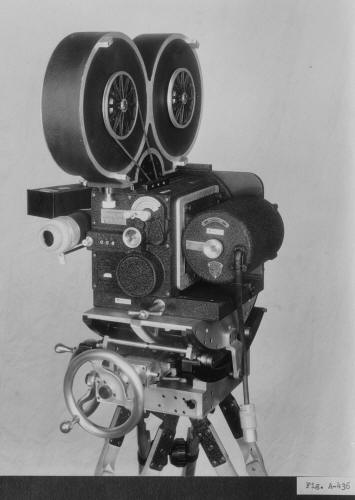 Fig. A-436.
Rear view of the Todd-AO Camera arranged to take the Bayonet Lenses. The
Special High-torque 30-frame Synchronous Motor is mounted on the camera. Fig. A-436.
Rear view of the Todd-AO Camera arranged to take the Bayonet Lenses. The
Special High-torque 30-frame Synchronous Motor is mounted on the camera.Todd-AO Camera (Cat. #01) Bayonet Lenses (Cat. #04, #05, #06) |
|
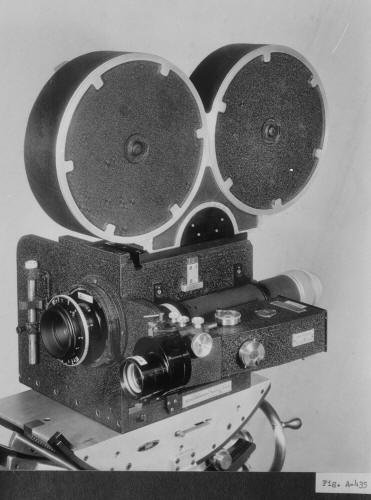 Fig. A-435.
Todd-AO Camera arranged to take the Bayonet Lenses with 48° Objectives and
37°-48° Follow Finder Adaptor. Fig. A-435.
Todd-AO Camera arranged to take the Bayonet Lenses with 48° Objectives and
37°-48° Follow Finder Adaptor.Todd-AO Camera (Cat. #01) Bayonet Lenses with 48° Objectives (Cat. #05) 37°-48° Follow Finder Adaptor (Cat. #15) |
|
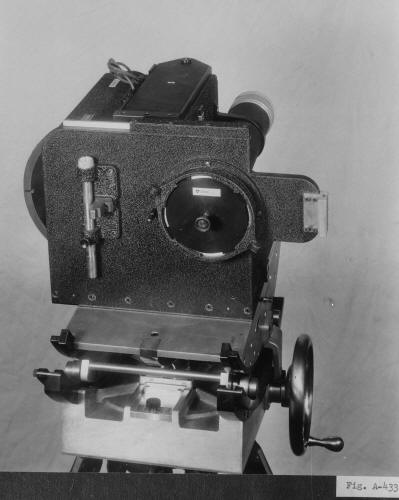 Fig. A-433.
Todd-AO Camera arranged to take the bayonet lenses, and mounted on a Geared
Pan & Tilt Head. Fig. A-433.
Todd-AO Camera arranged to take the bayonet lenses, and mounted on a Geared
Pan & Tilt Head.Todd-AO Camera (Cat. #01) Geared Pan & Tilt Head (Cat. #24) |
|
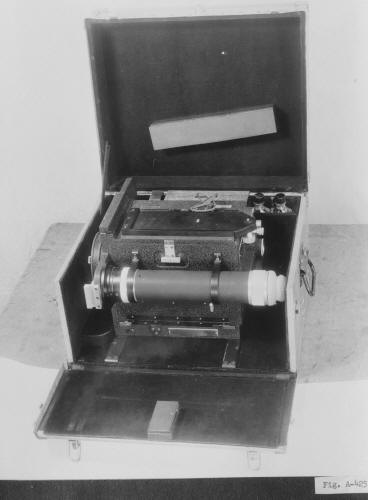 Fig. A-425.
Todd-AO Camera Box in its conveniently designed carrying case which includes
space for Filter Holder Box, lens cleaner oil, etc. Fig. A-425.
Todd-AO Camera Box in its conveniently designed carrying case which includes
space for Filter Holder Box, lens cleaner oil, etc.Todd-AO Camera Box (Cat. #01) Filter Holder Box (Cat. #22) |
|
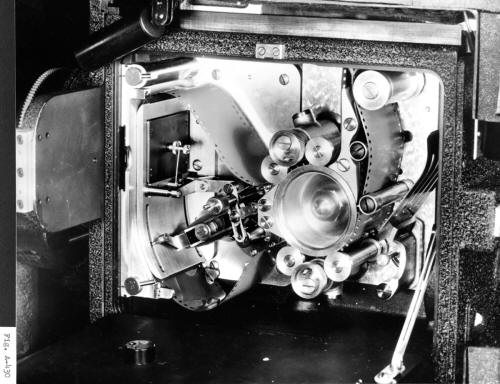 Fig.
A-430 Fig.
A-430Interior view of Todd-AO Camera Box, showing film movement and sprocket drive. Flanged keeper rollers on the sprocket help maintain better pre-positioning of the film and prevent film roll-offs and edge shaving due to loosely wound film rolls. Keeper roller eccentrics are of special high throw, designed so that film loops are more easily adjusted after film is located in the intermittent movement. Protective pins on keeper eccentrics and register pin throw-outs fit into recesses in the camera doors so that the doors cannot be closed with the camera in non-operating condition. The buckle trip switch at the right is designed with a special high-back-tilt trip pan which gives full buckle protection, but prevents inadvertent tripping by a small loop being temporarily formed on starting by the inertia of a nearly full take-up spool. Todd-AO Camera Box (Cat. #01) |
|
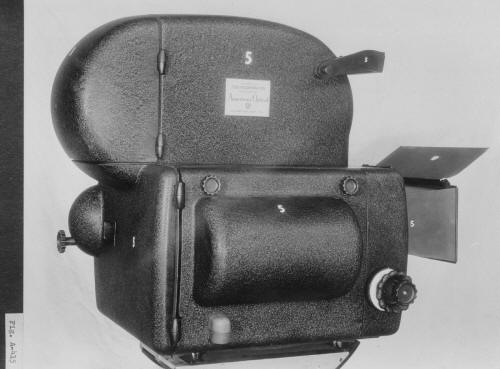 Fig. A-415.
Right side of Todd-AO Bayonet Camera Blimp, showing the Curved Contour
construction throughout which greatly reduces the sound transmission over
that of a blimp with flat surfaces which behave like a drumhead resonator.
The blimp is of bonded fiber-glass shell construction, which makes for high
strength and light weight. The internal sound insulation also acts as a heat
insulator, keeping camera and magazine exceptionally cool, even in direct
sunlight. Fig. A-415.
Right side of Todd-AO Bayonet Camera Blimp, showing the Curved Contour
construction throughout which greatly reduces the sound transmission over
that of a blimp with flat surfaces which behave like a drumhead resonator.
The blimp is of bonded fiber-glass shell construction, which makes for high
strength and light weight. The internal sound insulation also acts as a heat
insulator, keeping camera and magazine exceptionally cool, even in direct
sunlight.Todd-AO Bayonet Camera Blimp (Cat. #18) |
|
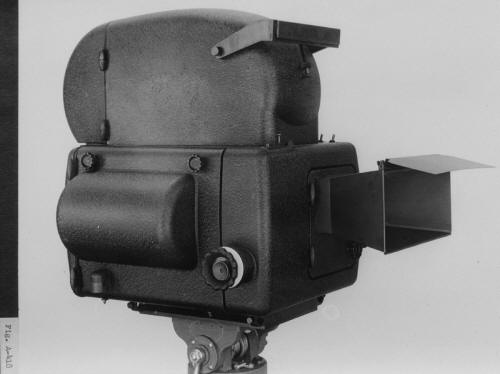 Fig. A-418.
Todd-AO Bayonet Camera Blimp showing sun-shade, right-hand follow focus
knobs and head spotlight bracket. Fig. A-418.
Todd-AO Bayonet Camera Blimp showing sun-shade, right-hand follow focus
knobs and head spotlight bracket.Todd-AO Bayonet Camera Blimp (Cat. #18) |
|
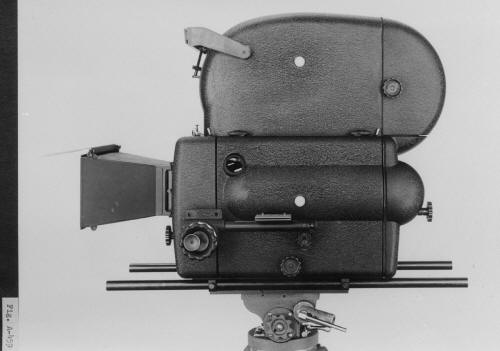 Fig. A-459.
Todd-AO Bayonet Camera Blimp, left hand side, showing parallax correcting
follow finder bracket and magnifying lens for lens focusing scale. Fig. A-459.
Todd-AO Bayonet Camera Blimp, left hand side, showing parallax correcting
follow finder bracket and magnifying lens for lens focusing scale.The white spots on the side of the magazine housing and of the loading door are magnetic door latches so that the door remains in the up (open) position while loading with no special latching needed. On the top main housing are three toggle switches which control the self-contained focusing scale light, loading light, and the footage counter light. Blimp carrying rods are shown in position under blimp. These would be removed in operation. Todd-AO Bayonet Camera Blimp (Cat. #18) |
|
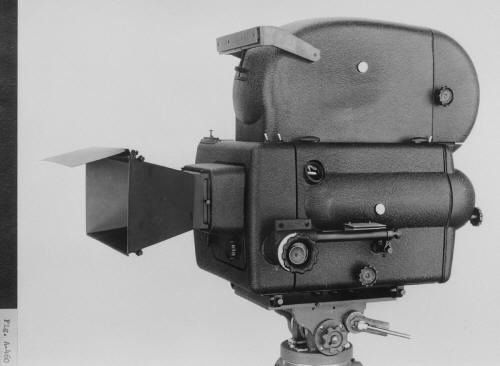 Fig. A-460.
Todd-AO Bayonet Camera Blimp showing the 64° lens hood and blimp front
extension door mounted in operating position. Fig. A-460.
Todd-AO Bayonet Camera Blimp showing the 64° lens hood and blimp front
extension door mounted in operating position.Todd-AO Bayonet Camera Blimp (Cat. #18) |
|
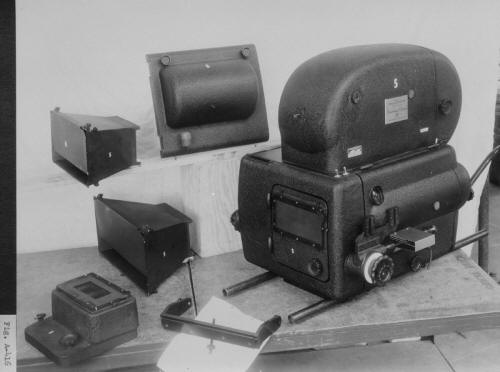 Fig. A-416.
Todd-AO Bayonet Camera Blimp with components. Mounted on the blimp is the
37°-48° lens front door, at the far lower left the interchangeable 64° door
to accommodate the longer 64° lens. The two sunshades are shown, one for the
64° and one for the 37°-48° objectives. The head spotlight bracket has been
removed, and the motor door has been removed and is in the rear. Fig. A-416.
Todd-AO Bayonet Camera Blimp with components. Mounted on the blimp is the
37°-48° lens front door, at the far lower left the interchangeable 64° door
to accommodate the longer 64° lens. The two sunshades are shown, one for the
64° and one for the 37°-48° objectives. The head spotlight bracket has been
removed, and the motor door has been removed and is in the rear.Todd-AO Bayonet Camera Blimp (Cat. #18) |
|
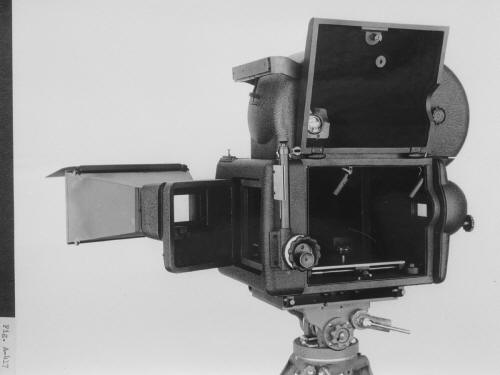 Fig. A-417.
Left side view of Todd-AO Bayonet Camera Blimp with the lens door and the
loading door in their open position, the loading door being held up by the
magnetic door latches. Fig. A-417.
Left side view of Todd-AO Bayonet Camera Blimp with the lens door and the
loading door in their open position, the loading door being held up by the
magnetic door latches.Todd-AO Bayonet Camera Blimp (Cat. #18) |
|
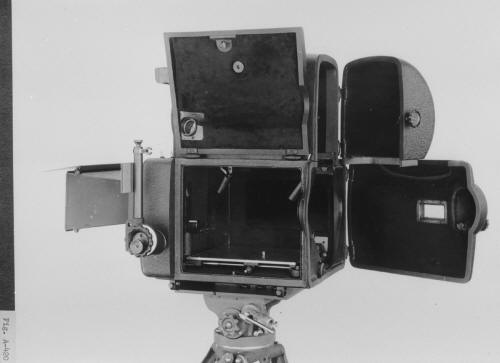 Fig. A-420.
Todd-AO Bayonet Camera Blimp showing it in loading position with the rear
door, magazine door, and the left-hand loading door open. Inside the blimp
can be seen the loading light and the rear footage counter light tubes. Fig. A-420.
Todd-AO Bayonet Camera Blimp showing it in loading position with the rear
door, magazine door, and the left-hand loading door open. Inside the blimp
can be seen the loading light and the rear footage counter light tubes.Todd-AO Bayonet Camera Blimp (Cat. #18) |
|
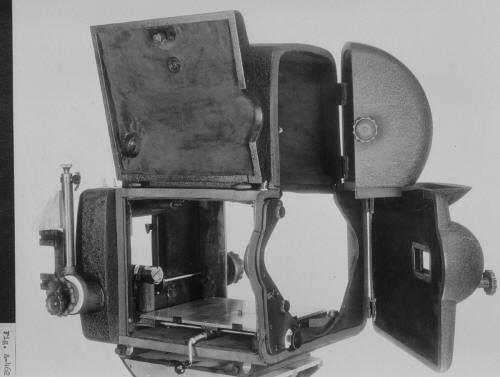 Fig. A-462.
Todd-AO Bayonet Camera Blimp, completely open, with motor door off. This
shows the acoustically mounted stable platform on which the camera rests,
the follow focus mechanism with its sound-absorbing couplings which,
nevertheless, provide torsional stiffness to prevent back lash in follow
focus. All door latches are the Bayonet latch type for speed of operation.
Raised at left is the parallax correcting follow finder mount. Fig. A-462.
Todd-AO Bayonet Camera Blimp, completely open, with motor door off. This
shows the acoustically mounted stable platform on which the camera rests,
the follow focus mechanism with its sound-absorbing couplings which,
nevertheless, provide torsional stiffness to prevent back lash in follow
focus. All door latches are the Bayonet latch type for speed of operation.
Raised at left is the parallax correcting follow finder mount.Todd-AO Bayonet Camera Blimp (Cat. #18) |
|
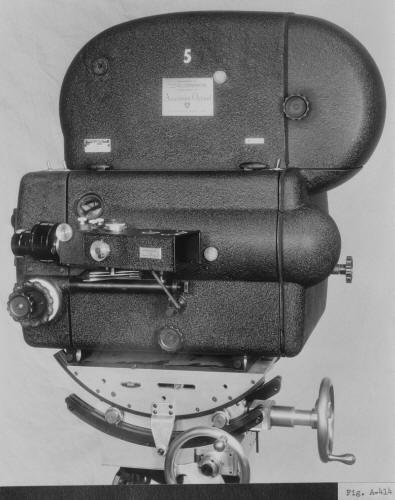 Fig. A-414.
Todd-AO Bayonet Camera Blimp ready for operation, mounted on the Geared
Tripod Head.
The parallax compensating follow finder arrangement is shown set for use
with the 37° Bayonet Lens. Fig. A-414.
Todd-AO Bayonet Camera Blimp ready for operation, mounted on the Geared
Tripod Head.
The parallax compensating follow finder arrangement is shown set for use
with the 37° Bayonet Lens.Todd-AO Bayonet Camera Blimp (Cat. #18) Geared Tripod Head (Cat. #24) 37° Bayonet Lens (Cat. #04) |
|
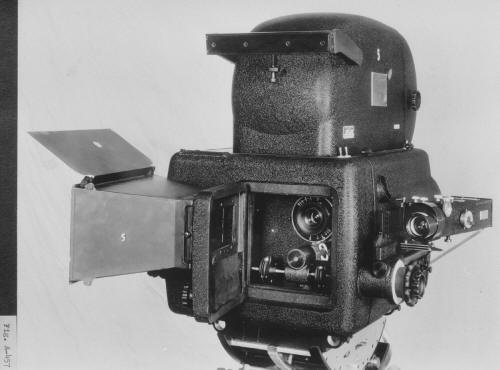 Fig. A-457.
Todd-AO Bayonet Camera Blimp with camera, showing front lens access door
open with follow focus mechanism engaged to lens ring gear. Fig. A-457.
Todd-AO Bayonet Camera Blimp with camera, showing front lens access door
open with follow focus mechanism engaged to lens ring gear.Todd-AO Bayonet Camera Blimp (Cat. #18) |
|
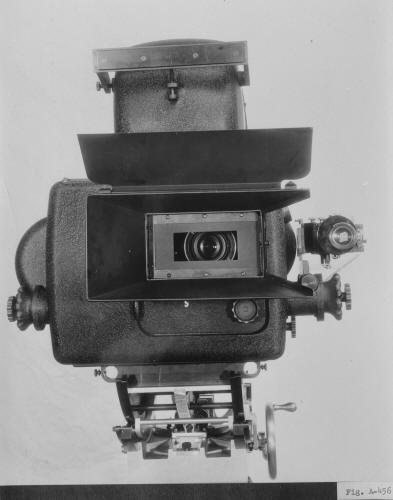 Fig. A-456.
Front view of Todd-AO Bayonet Camera Blimp with camera, showing side section
of sunshade removed for shooting of close-ups in order to give full view to
the follow finder. Fig. A-456.
Front view of Todd-AO Bayonet Camera Blimp with camera, showing side section
of sunshade removed for shooting of close-ups in order to give full view to
the follow finder.Todd-AO Bayonet Camera Blimp (Cat. #18) |
|
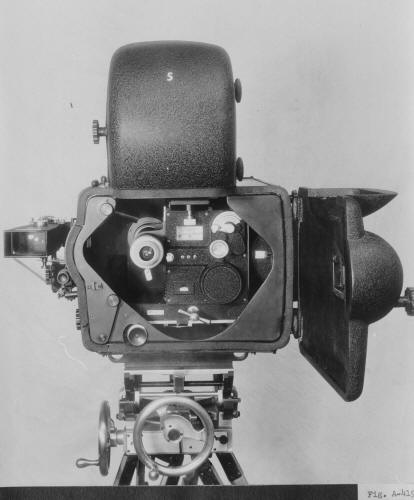 Fig. A-419.
Rear view of Todd-AO Bayonet Camera Blimp showing operator's door open with
Todd-AO Bayonet Camera racked-over into focusing position. Rear operator's
focusing knob can be seen below camera. Fig. A-419.
Rear view of Todd-AO Bayonet Camera Blimp showing operator's door open with
Todd-AO Bayonet Camera racked-over into focusing position. Rear operator's
focusing knob can be seen below camera.Todd-AO Bayonet Camera Blimp (Cat. #18) Todd-AO Bayonet Camera (Cat. #01) |
|
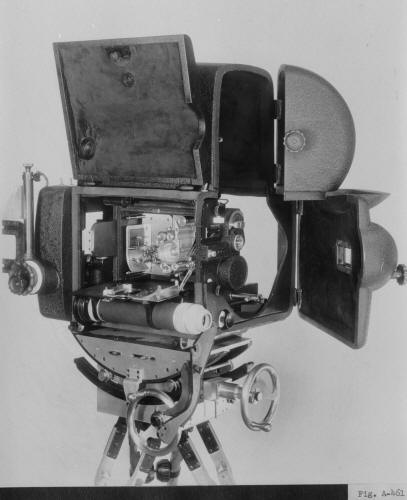 Fig. A-461.
Todd-AO Bayonet Camera Blimp with camera, shown open in position for
reloading with motor door removed and camera door open. Fig. A-461.
Todd-AO Bayonet Camera Blimp with camera, shown open in position for
reloading with motor door removed and camera door open.Todd-AO Bayonet Camera Blimp (Cat. #18) |
|
| Go: back - top - back issues - news index Updated 21-01-24 |
